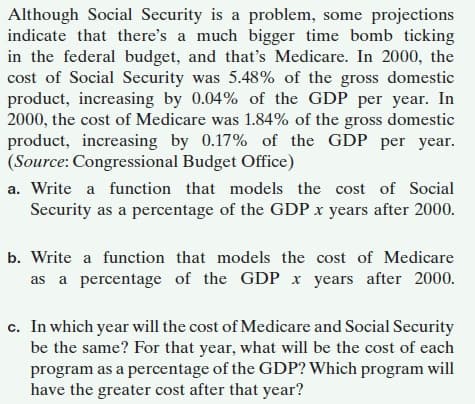Although Social Security is a problem, some projections indicate that there's a much bigger time bomb ticking in the federal budget, and that's Medicare. In 2000, the cost of Social Security was 5.48% of the gross domestic product, increasing by 0.04% of the GDP per year. In 2000, the cost of Medicare was 1.84% of the gross domestic product, increasing by 0.17% of the GDP per year. (Source: Congressional Budget Office) a. Write a function that models the cost of Social Security as a percentage of the GDP x years after 2000. b. Write a function that models the cost of Medicare as a percentage of the GDP x years after 2000. c. In which year will the cost of Medicare and Social Security be the same? For that year, what will be the cost of each program as a percentage of the GDP? Which program will have the greater cost after that year?
Although Social Security is a problem, some projections indicate that there's a much bigger time bomb ticking in the federal budget, and that's Medicare. In 2000, the cost of Social Security was 5.48% of the gross domestic product, increasing by 0.04% of the GDP per year. In 2000, the cost of Medicare was 1.84% of the gross domestic product, increasing by 0.17% of the GDP per year. (Source: Congressional Budget Office) a. Write a function that models the cost of Social Security as a percentage of the GDP x years after 2000. b. Write a function that models the cost of Medicare as a percentage of the GDP x years after 2000. c. In which year will the cost of Medicare and Social Security be the same? For that year, what will be the cost of each program as a percentage of the GDP? Which program will have the greater cost after that year?
Chapter7: Systems Of Equations And Inequalities
Section7.2: Systems Of Linear Equations: Three Variables
Problem 61SE: Last year, at Haven's Pond Car Dealership, for a particular model of BMW, Jeep, and Toyota, one...
Related questions
Question

Transcribed Image Text:Although Social Security is a problem, some projections
indicate that there's a much bigger time bomb ticking
in the federal budget, and that's Medicare. In 2000, the
cost of Social Security was 5.48% of the gross domestic
product, increasing by 0.04% of the GDP per year. In
2000, the cost of Medicare was 1.84% of the gross domestic
product, increasing by 0.17% of the GDP per year.
(Source: Congressional Budget Office)
a. Write a function that models the cost of Social
Security as a percentage of the GDP x years after 2000.
b. Write a function that models the cost of Medicare
as a percentage of the GDP x years after 2000.
c. In which year will the cost of Medicare and Social Security
be the same? For that year, what will be the cost of each
program as a percentage of the GDP? Which program will
have the greater cost after that year?
Expert Solution
This question has been solved!
Explore an expertly crafted, step-by-step solution for a thorough understanding of key concepts.
This is a popular solution!
Trending now
This is a popular solution!
Step by step
Solved in 2 steps

Recommended textbooks for you


College Algebra (MindTap Course List)
Algebra
ISBN:
9781305652231
Author:
R. David Gustafson, Jeff Hughes
Publisher:
Cengage Learning

Algebra for College Students
Algebra
ISBN:
9781285195780
Author:
Jerome E. Kaufmann, Karen L. Schwitters
Publisher:
Cengage Learning


College Algebra (MindTap Course List)
Algebra
ISBN:
9781305652231
Author:
R. David Gustafson, Jeff Hughes
Publisher:
Cengage Learning

Algebra for College Students
Algebra
ISBN:
9781285195780
Author:
Jerome E. Kaufmann, Karen L. Schwitters
Publisher:
Cengage Learning


Elementary Geometry For College Students, 7e
Geometry
ISBN:
9781337614085
Author:
Alexander, Daniel C.; Koeberlein, Geralyn M.
Publisher:
Cengage,
